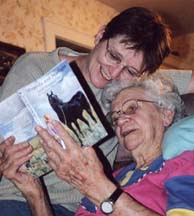Wearing "many hats" as they say (not that I ever wear a hat) has both advantages and downsides. As a publisher—yeah! CEO of my company, small as it is—I have many jobs and have enjoyed learning them all. Tackling so many challenges certainly lends spice and variety to life. It has broadened my perspective, experiences, and acquaintence with more people than I could ever have met otherwise. Yet it's not my first love and often runs counter to my naturally creative side. My first love is storytelling, creating volumes of books that I have dubbed "true fiction," a name derived from quotes by Wallace Stegner and John Gardner. Stegner said in his book, "On Teaching and Writing Fiction, "It is fiction as truth that I am concerned with here, fiction that reflects experience instead of escaping it, that stimulates instead of deadening." And Gardner, in "On Moral Fiction" said, "true art is moral: it seeks to improve life, not debase it."
My books began when a child asked me to tell her a story. From there it was easy sailing because I knew the character, who acquired characteristics and experiences from my own childhood, that of my daughters, and especially, my granddaughter—the child who asked me to tell her the story. Adding her problems—a nontraditional family situation and a new school in which she didn't feel welcome—and her wishes, "a regular family," friends, and "a horse of my very own," the story told itself. The first book, Miranda and Starlight, begged for a sequel. More followed until Miranda, who began as a ten year old turned fourteen at the end of the sixth and final book. Young girls who love horses became avid fans, not just for the horse lore, but for experiences they could relate to. One young lady from Texas told me, "Before I read Miranda and Starlight, I hated reading. Your books have changed my life. Never stop writing books!" (Katherine Wade, age 11) Others have said. Miranda is just like me. I felt like I was there.
I wrote "Danny's Dragon: a story of wartime loss" for all the children in my neighborhood and in the news whose parents (one or both) were sent away from them to fight the war in Iraq. Putting myself in the place of a Montana ranch boy whose father became a casualty, I created ten-year-old Danny to show the devastating affects of such loss, the stages of grief he goes through, and the changes wrought in the family dynamics and even the physical lifestyle as a result of the loss. One child who lost her father read the story and said, "I knew Danny's feeling very well. He acted exactly like I did when I lost my father," Katie Wade, age 13.
Most children find it difficult to talk to a teacher, counselor, or even a parent about their own feelings and problems; the deeper the feeling, the harder it is to talk about. It's much easier to discuss the character in a book and say, for example, "Miranda feels the same way I do." or "The reason I acted like I did is because I was feeling just like Danny felt." This makes true fiction—my own, those I've published for other authors—and many other books that qualify as my definition for true fiction, an effective tool for children to understand and express themselves and for adults to open communication with a child.
Whatever happens with publishing, I know I will continue to write true fiction as long as I am able to sit at a key board or hold a pen in my hand. I can't NOT write. I am currently working on a trilogy about orphan (or semi orphan) twins who were separated at the age of four. Kendall, who lives with his nomadic father, is shy, fearful, and lonely. Kyleah, who lives in a distant foster home, longs to be beautiful so that people will want her, yet she is afraid that if she loves anyone, they will leave her. When a foster brother talks her into running away with him, adventures with important lessons abound.
Well, work calls, and so does Kendall. Must run.
Tuesday, June 5, 2007
Subscribe to:
Post Comments (Atom)


No comments:
Post a Comment